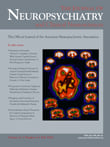Antipsychotic Induced Catatonia: A Case of Probable Dementia With Lewy Bodies
To the Editor: This report describes the case of a patient who presented with catatonia after rapid escalation of antipsychotic dose. The patient was eventually diagnosed with probable dementia with Lewy bodies (DLB).
Case Report
Mr. A was a 51-year-old man who presented with distressing visual hallucinations and paranoia. After outpatient psychiatric evaluation, risperidone, 0.5 mg twice daily, was changed to paliperidone, 6 mg once daily. After a single dose, he became confused and ataxic and was taken to the emergency room for evaluation. No medical causes for his symptoms were found, and he was admitted to an inpatient psychiatric unit.
His examination was notable for mutism, constricted affect, and lead-pipe rigidity of the upper extremities. His responses were limited to intermittent staring at examiners. When assisted to a standing position, he remained standing but would not move. Catatonia was diagnosed, and lorazepam, 1 mg twice a day, and aripiprazole, 5 mg once daily, were started. Paliperidone was discontinued.
The following day, his mutism persisted and he would not respond to multiple interview attempts. Although he made scant eye contact, he continued to be noninteractive. He required staff assistance with transferring from bed and continued to decline food intake. Vital signs were well within normal limits. Laboratory studies were normal. CT of the head revealed no parenchyma changes or other acute abnormalities. Aripiprazole was discontinued after a single dose due to concern for neuroleptic malignant syndrome (NMS), while lorazepam was increased to 2 mg three times a day. The patient became less responsive after a total of 8 mg of lorazepam, and he was transferred to the neurology service. Laboratory studies and CSF analysis were unremarkable. EEG showed diffuse slowing with no epileptiform discharges. Lorazepam was discontinued.
Over the subsequent 48 hours, the patient’s level of consciousness improved to where he started to converse minimally. Examination revealed bradykinesia, asymmetric rigidity, shuffling gait, and hypophonia. A history of cognitive decline was obtained, and a diagnosis of dementia with Lewy bodies (DLB) was made. His motor symptoms improved significantly, and he was eventually discharged with donepezil, L -dopa/carbidopa, and low-dose quetiapine.
Discussion
Dementia with Lewy bodies is considered the second most common cause of dementia after Alzheimer’s disease, although it is still under recognized. 1 The extreme negativism and motor findings found in catatonia involve frontal and extrapyramidal systems. 2 Dementia with Lewy bodies patients are highly sensitive to antipsychotics because neurodegeneration of the same neurological pathways occurs. Catatonia and mutism in DLB patients have also been reported. 3 , 4 Paliperidone, the principal active metabolite of risperidone, is roughly equipotent to risperidone. The patient’s previously undiagnosed DLB predisposed him to acute catatonia when an antipsychotic with a relatively high extrapyramidal side effect profile was increased by up to times six. 5 This is the first case in the literature that we are aware of that demonstrates a possible link between paliperidone and catatonia in a patient with DLB. This case affirms the importance of slow titration of high potency antipsychotics with special consideration for DLB in atypical presentations of psychosis.
1. Weintraub D, Hurtig HI: Presentation and management of psychosis in Parkinson’s disease and dementia with Lewy bodies. Am J Psychiatry 2007; 164:1491–1498Google Scholar
2. Blumer D: Catatonia and the antipsychotics: psychobiologic significance of remote and recent findings. Compr Psychiatry 1997; 38:193–201Google Scholar
3. Morita S, Miwa H, Kondo T: A patient with probable dementia with Lewy bodies, who showed catatonia induced by donepezil: a case report. No To Shinkei 2004; 56:881–884Google Scholar
4. McKeith IG, Ballard CG, Harrison RW: Antipsychotic sensitivity to ripseridone in Lewy body dementia. Lancet 1995; 346:699Google Scholar
5. Dolder C, Nelson M, Deyo Z: Paliperidone for schizophrenia. Am J Health Syst Pharm 2008; 65:403–413Google Scholar



